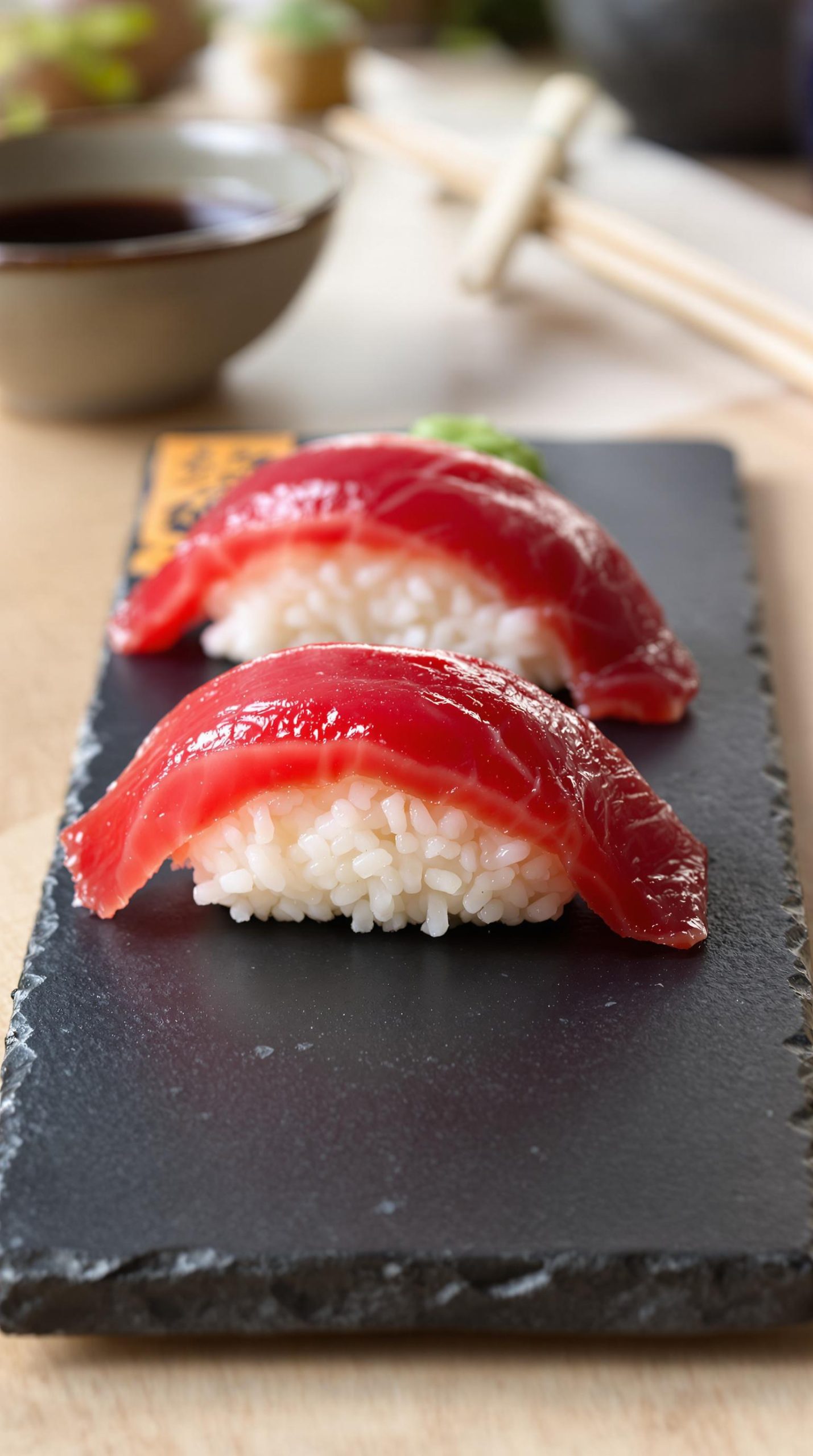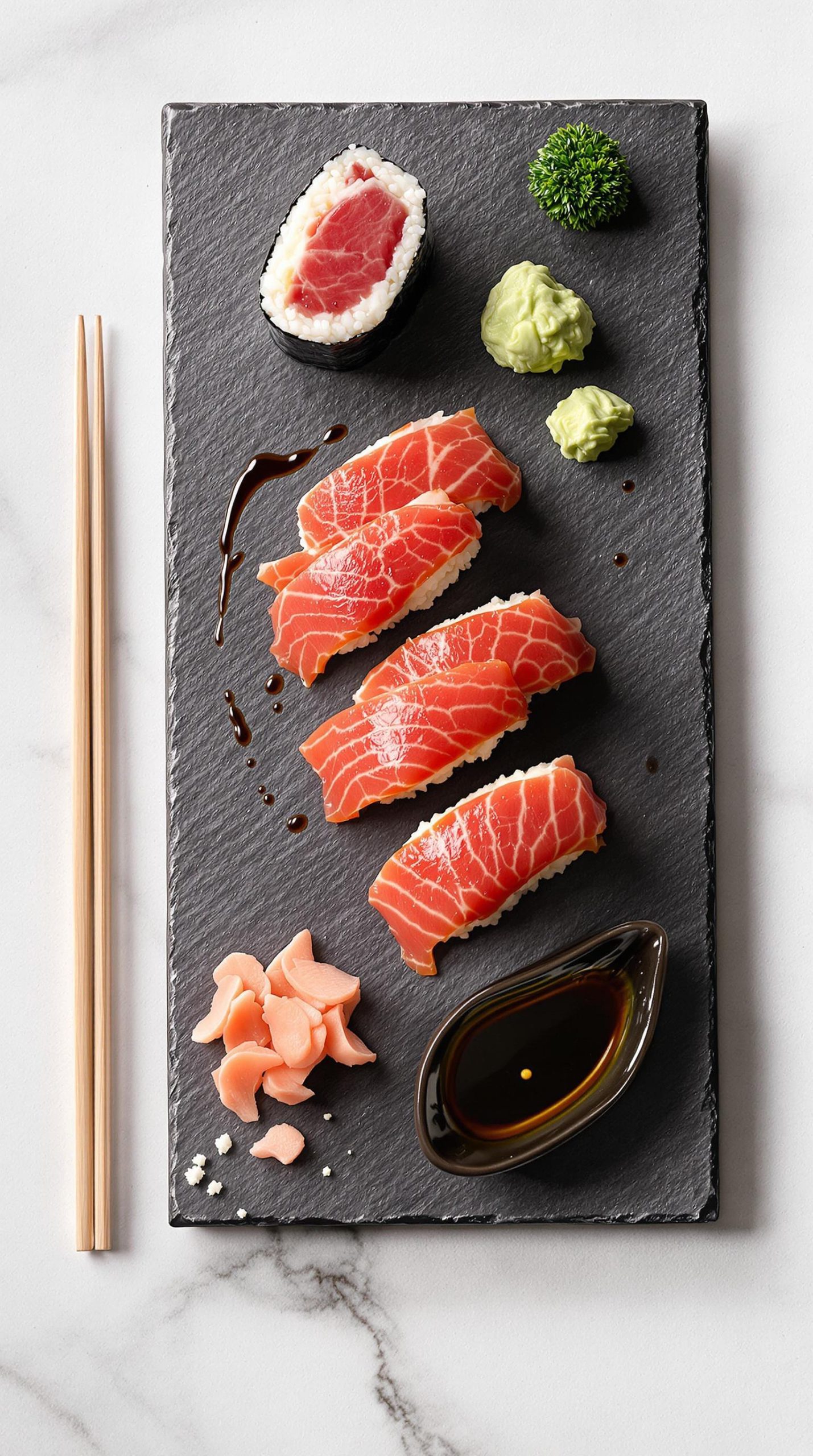Why You’ll Love this Classic Japanese Tuna Sushi
Simplicity often yields the most extraordinary culinary experiences, and this classic Japanese tuna sushi is no exception.
With just two ingredients—pristine raw tuna and perfectly seasoned rice—you’ll create something truly magical on your plate.
I’m convinced you’ll appreciate how this dish celebrates the natural flavors without hiding behind complicated sauces or techniques.
The silky texture of fresh tuna against the subtle vinegar notes in the rice? Absolute perfection.
And can we talk about impressive dinner party options? Nothing says “I’ve got culinary skills” quite like homemade sushi that looks restaurant-worthy but requires minimal effort.
What Ingredients are in Classic Japanese Tuna Sushi?
Classic Japanese tuna sushi, or maguro nigiri as it’s traditionally known, represents the beautiful simplicity of Japanese cuisine. What makes this dish so extraordinary is that it requires just two perfectly balanced ingredients that work in harmony to create something greater than the sum of its parts.
The quality of these ingredients matters tremendously—you simply can’t hide subpar fish or poorly prepared rice when there’s nothing else to distract the palate.
- 1 ounce raw fresh tuna (sashimi-grade)
- 1 ounce cooked sushi rice (short-grain rice seasoned with rice vinegar, sugar, and salt)
When sourcing your ingredients, I can’t stress enough how important freshness is for the tuna. You’ll want to find sashimi-grade fish from a reputable fishmonger or Japanese market, as regular supermarket fish isn’t usually safe for raw consumption.
The rice, while seeming simple, requires attention too—it should be properly seasoned and cooled to room temperature before making your sushi, maintaining that perfect sticky-yet-separate texture that defines good sushi rice.
Wondering about wasabi, soy sauce, or pickled ginger? While these are traditional accompaniments served alongside, they’re not technically part of the sushi itself, which maintains its beautiful minimalist approach.
How to Make this Classic Japanese Tuna Sushi

Making classic tuna sushi at home is remarkably simple, though the artistry comes through in the details. Begin by preparing 1 ounce of sushi rice per piece you plan to make. The rice should be at room temperature—warm enough to be pliable but not hot enough to cook the fish.
Take a small amount of water in a bowl and lightly wet your hands (this prevents the rice from sticking to your fingers, a game-changer I wish someone had told me sooner). Gently form the rice into an oval shape with your dominant hand, applying just enough pressure to make it hold together without compacting it too much. Rice that’s too dense creates a heavy, gummy sushi experience.
Next, take your 1 ounce slice of fresh raw tuna and place it atop the rice mound. The fish should be cut against the grain in a clean, precise slice that’s about 1/4 inch thick—thin enough to be tender but substantial enough to provide a satisfying bite. Traditional preparation calls for a tiny dab of wasabi between the rice and fish, though this is entirely optional based on your heat preference.
The wasabi acts not just as a flavor enhancer but also as a natural antibacterial agent, a clever bonus from centuries of sushi-making wisdom.
The final touch is perhaps the most important—a gentle press of your index and middle fingers across the top of the fish, lightly securing it to the rice beneath while maintaining its beautiful shape. This motion requires a delicate touch; you want to compress just enough for the components to adhere without mangling your creation.
For perfectly uniform fish slices, a quality mandoline slicer can provide the precision needed for professional-looking sushi presentations at home.
A stand mixer can be invaluable for preparing large batches of sushi rice, ensuring even seasoning distribution without overworking the grains.
Remember that presentation matters tremendously in Japanese cuisine, so take a moment to admire and adjust your handiwork before serving. Arrange your nigiri on a plate, preferably with the fish slightly overhanging the rice on both sides, showcasing the gorgeous deep red color that makes maguro such a prized sushi selection.
Classic Japanese Tuna Sushi Substitutions and Variations
While traditional tuna sushi holds a special place in Japanese cuisine, you don’t need to feel constrained by convention when making it at home.
Try salmon or yellowtail if tuna isn’t available—both offer delicious alternatives with different flavor profiles. Not a fan of raw fish? Cooked shrimp, smoked salmon, or even thinly sliced avocado can work beautifully.
For the rice, brown sushi rice provides a nuttier taste and more fiber.
Can’t find sushi rice? Short-grain rice will do in a pinch, though the texture won’t be quite as sticky.
The possibilities are endless, really. What matters is creating something you’ll enjoy eating.
What to Serve with Classic Japanese Tuna Sushi
Now that you’re comfortable customizing your tuna sushi, let’s talk about what to serve alongside it.
I always reach for a small dish of high-quality soy sauce, wasabi paste, and pickled ginger—the holy trinity of sushi accompaniments.
A light cucumber salad with rice vinegar dressing complements the rich tuna perfectly.
Don’t forget a cup of green tea or sake to cleanse your palate between bites.
For a complete meal, consider miso soup as a starter.
It’s warming, comforting, and honestly, just feels right with sushi.
Trust me, these simple sides let your tuna sushi shine.
Final Thoughts
After mastering this classic tuna sushi recipe, you’ll have revealed a timeless culinary skill that brings Japan’s rich traditions into your own kitchen.
There’s something deeply satisfying about creating these perfect little bites with your own hands.
Remember, sushi-making is both art and meditation—a practice that improves with time.
Don’t get discouraged if your first rolls aren’t picture-perfect. Mine certainly weren’t!
What matters is the fresh flavor and the joy of creation.
If you enjoy homemade comfort food, you might also appreciate making classic meatloaf with ground beef, breadcrumbs and vegetables for a completely different culinary experience.
I hope this simple tuna nigiri becomes your gateway to exploring more sushi variations.
Who knows? You might find yourself hosting your own sushi nights before long.




